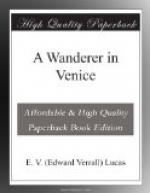The adjoining chapel is that named after Cardinal Zeno, who lies in the magnificent central tomb beneath a bronze effigy of himself, while his sacred hat is in crimson mosaic on each side of the altar. The tomb and altar alike are splendid rather than beautiful: its late Renaissance sculptors, being far removed from Donatello, Mino, and Desiderio, the last of whom was one of the authors of the beautiful font in the adjoining Baptistery. Earlier and more satisfactory reliefs are those of an angel on the right of the altar and a Madonna and Child on the left which date from a time when sculpture was anonymous. The mosaics represent the history of S. Mark.
One may walk or sit at will in S. Mark’s as long as one wishes, free and unharassed; but a ticket is required for the galleries and a ticket for the choir and treasury; and the Baptistery and Zeno chapel can be entered only by grace of a loafer with a key who expects something in return for opening it. The history of this loafer’s privilege I have not obtained, and it would be interesting to learn by what authority he is there, for he has no uniform and he accepts any sum you give him. If all the hangers-on of the Roman Catholic Church, in Italy alone, who perform these parasitical functions and stand between man and God, could be gathered together, what a huge and horrible army it would be!
CHAPTER IV
THE PIAZZA AND THE CAMPANILE
The heart of Venice—Old-fashioned music—Teutonic invaders—The honeymooners—True republicanism—A city of the poor—The black shawls—A brief triumph—Red hair—A band-night incident—The pigeons of the Piazza—The two Procuratie—A royal palace—The shopkeepers—Florian’s—Great names—Venetian restaurants—Little fish—The old campanile—A noble resolve—The new campanile—The angel vane—The rival campanili—The welcome lift—The bells—Venice from the Campanile.
S. Mark’s Square, or the Piazza, is more than the centre of Venice: to a large extent it is Venice. Good Venetians when they die flit evermore among its arcades.
No other city has so representative a heart. On the four musical nights here—afternoons in the winter—the Piazza draws like a magnet. That every stranger is here, you may be sure, and most Venetian men. Some sit outside Florian’s and the other cafes; others walk round and round the bandstand; others pause fascinated beside the musicians. And so it has been for centuries, and will be. New ideas and fashions come slowly into this city, where one does quite naturally what one’s father and grandfather did; and a good instance of such contented conservatism is to be found in the music offered to these contented crowds, for they are still true to Verdi, Wagner, and Rossini, and with reluctance are experiments made among the newer men.




